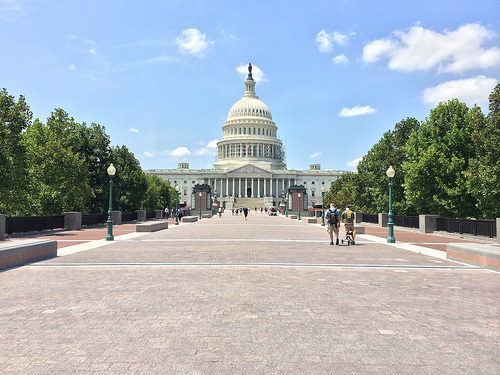Nearly all regulatory laws provide for civil – and sometimes even criminal – penalties for noncompliance. Penalty amounts (“XXX dollars per day of violation” for example) are typically adopted as part of the original legislation. But over time, the relative sting of these penalties declines with inflation. To counteract the possibility that less painful penalties will be less effective incentives for compliance, U.S. federal law has directed most agencies to make periodic “cost of living” adjustments to maximum available civil penalty levels (there are no provisions for standing periodic adjustments to criminal penalties).
How Did These Requirements Work During 1990-2016?
The first version of this approach was enacted by the Federal Civil Penalties Inflation Adjustment Act of 1990, which directed the President to report annually on any adjustments made under existing statutory authority, and to calculate what such adjustments would have been if more agencies had the authority to make them.
Congress amended the Act in 1996 to require most agencies to make inflation adjustments every four years, but precluding adjustments to penalties under the following:
Read More
Tags:
Business & Legal,
OSHA,
Environmental,
EPA,
directors,
directors & officers
For many years, federal and state environmental enforcement agencies have been willing to negotiate settlements in which defendants agree to conduct “supplemental environmental projects (SEPs)” as a way to reduce formal penalties for the noncompliance that led the agency investigation and enforcement. Proponents see SEPs as a way to promote environmental and health values by encouraging defendants to undertake projects that wouldn’t occur otherwise in order to reduce or eliminate civil and/or criminal liability. Opponents see them as rogue efforts in which prosecutors substitute their own judgment for the statutory and regulatory directives that are supposed to guide their actions.
Read More
Tags:
Environmental risks,
Environmental,
EPA
Even workplaces with very limited chemical use probably use cleaning supplies. If these supplies are bought in typical retail packaging intended for consumer use, the employer and employees may lack ready access to chemical content information beyond that on the labels. That’s because the Hazard Communication Standard (Hazcom) administered by the U.S. Occupational Safety and Health Administration (OSHA) exempts consumer products in their final form for consumer use, unless worker use is greater than that by typical consumers.
Read More
Tags:
Health & Safety,
OSHA,
California Legislation,
Environmental risks,
Environmental,
EHS,
Hazcom
Since 2012, California has administered a “cap-and-trade” program, setting total greenhouse gas (GHG) emission limits from selected major emitting sectors and creating tradeable emission permits and offsets to provide flexibility and encourage innovation. The program was created under authority of the state’s 2006 “AB 32” legislation, which focuses on reducing statewide GHG emissions by 2020. This authority would have expired in 2020, but new legislation extends the program until 2030. In order to secure enough votes for the extension, legislative leaders and Governor Brown agreed to statutory changes in this program and related air quality programs.
Read More
Tags:
California Legislation,
Environmental risks,
Environmental,
Greenhouse Gas,
ghg,
cap-and-trade
One of California’s many unique environmental, health and safety (EH&S) laws is its “Corporate Criminal Liability Act (CCLA).” CCLA provides greatly expanded potential personal criminal liabilities for violations by managers, so is often referred to as the “Be a Manager, Go to Jail” law. Enacted in 1990, CCLA draws both from occupational safety and product liability laws, to provide sweeping requirements for corporations and managers to abate or warn exposed individuals (including employees) about a broad variety of serious concealed dangers occurring in a broad variety of circumstances, including both workplaces and products. Although this law has been used by prosecutors and advocates to strike fear into the hearts of corporate managers, there have been few reported cases in its nearly three decades on the books.
Read More
Tags:
Health & Safety,
OSHA,
California Legislation,
Environmental risks,
Environmental
On June 27, 2017 the Environmental Protection Agency (EPA) and the U.S. Army Corps of Engineers (Corps) jointly proposed to revise their regulatory definitions of “waters of the United States”, applying authority under the Clean Water Act (CWA). Their proposals would rescind expansive versions adopted in June 2015, during the Obama Administration, and reinstate the text of the definitions in place until 2015. These actions represent the latest chapter in a saga dating back to United States Supreme Court decisions in 2001 and 2006 overturning decades-long understandings of which waters CWA empowers the agencies to regulate. (I wrote about this history in a blog about the 2015 rules here).
Read More
Tags:
Environmental risks,
Environmental,
EPA,
Stormwater,
clean water
On May 23, the Trump Administration issued its budget proposal for federal Fiscal Year (FY) 2018 (October 1, 2017 through September 30, 2018), subtitled “A New Foundation for America’s Greatness”. The proposal includes a 31% cut in the Environmental Protection Agency (EPA) budget, from $8.2 billion in FY 2016 (stable in FY 2017 under a Continuing Budget Resolution rather than a fully-new federal budget), to $5.7 billion for FY 2018, with corresponding personnel cuts from 15,376 full-time-equivalent employees (FTE) to 11,611. Although presidents’ annual budget proposals are rarely enacted in full, they do mark the formal start of annual considerations of federal policies and staffing. It’s therefore useful to review how President Trump and EPA Administrator Pruitt hope to proceed.
Read More
Tags:
Environmental risks,
Environmental,
EPA,
climate change
On June 1, President Trump announced that the United States will withdraw from the Paris Accord on climate change, and then seek to “begin negotiations to reenter either the Paris Accord or a really entirely new transaction on terms that are fair to the United States, its businesses, its workers, its people, its taxpayers.” Most of the strong reactions I’ve seen – pro and con – express only superficial approaches to the implications of the decision. In this note I’ll dig a little deeper, and propose two different less-superficial ways to watch these implications play out.
Read More
Tags:
Environmental risks,
Environmental,
EPA,
climate change
On December 1, 2016, ASTM International (ASTM) approved revisions to ASTM E2247-08, Standard Practice for Environmental Site Assessments: Phase I Environmental Site Assessment Process for Forestland or Rural Property. The revisions were made as part of ASTM’s normal review process and through a working group of ASTM’s Committee E50 on Environmental Assessment, Risk Management, and Corrective Action. The changes are aimed at prospective purchasers conducting All Appropriate Inquiries (AAI) on forestland and rural property, and include updated methodology for site reconnaissance, clarified language for recognized environmental conditions, and removal of unessential information. This current version, now designated E2247-16, replaces the “historic” 2008 version as ASTM’s current consensus-based standard.
Read More
Tags:
Environmental risks,
Environmental,
site auditing
On April 26, a federal district judge in Houston issued an order assessing Exxon Mobil nearly $20 million in civil penalties for thousands of Clean Air Act (CAA) violations at Exxon’s massive Baytown, Texas refinery and petrochemical complex. This decision is the latest in a long-running “citizen suit” enforcement case, seeking additional penalties to claw back the “economic benefits from noncompliance,” on top of nearly $1.5 million in civil penalties already assessed by the Texas Commission on Environmental Quality (TCEQ) for the same violations. This decision illustrates the power of these private enforcement cases, which may become more important if the Trump Administration eases its own enforcement efforts.
Read More
Tags:
Environmental risks,
Environmental,
ghg,
climate change










